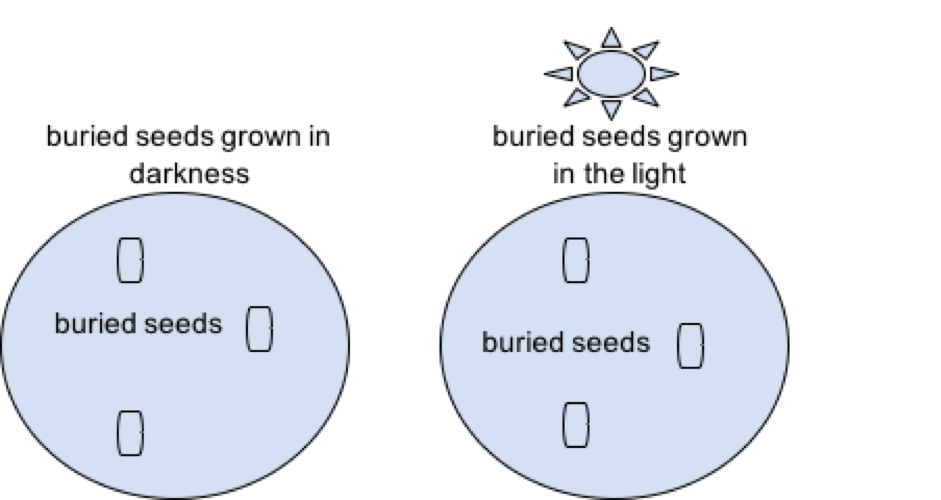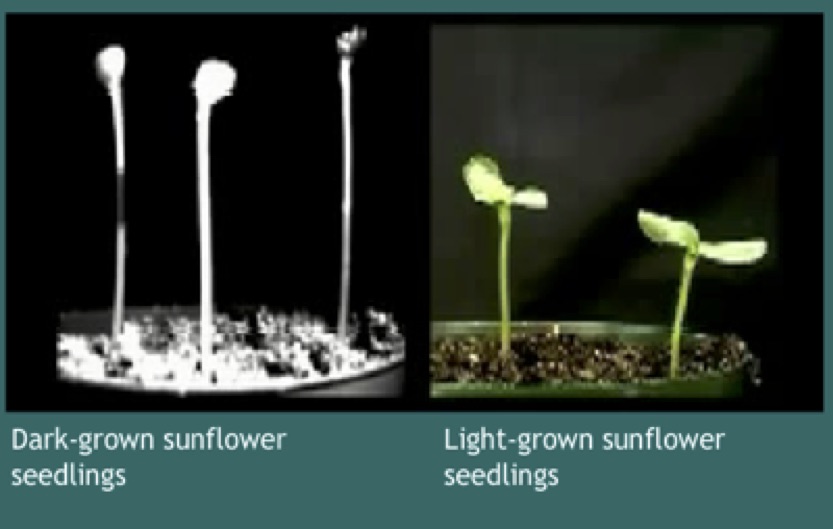Title: Light vs. Darkness. Where will seeds sprout and grow faster?
Concepts: Plant Growth-cell division, Energy transformations, Photosynthesis, Gardening
Brief Introduction
When starting a garden, seeds are often germinated indoors before being transplanted to the outside garden when the temperature warms. Picking the right conditions for getting seeds to germinate and grow properly is critical to starting a healthy garden.
Question (admittedly a bit misleading, but sets up the discrepant event, great opportunity for productive talk around the thinking about their predictions):
When do seeds grow taller? In the dark or in the light?

The actual phenomenon or problem:
Original video is available by searching “Plants-In-Motion PBS” and showing video #2. (http://indiana.pbslearningmedia.org/asset/lsps07_int_plantmovies/) or on youtube at https://www.youtube.com/watch?v=yx7aI3Kyvo0&feature=youtu.be
End of video snapshot:

Short explanation of the science or math involved
From PBS Plants-In-Motion website. “The sunflower seedlings on the left are seen growing in the darkness. Despite having reached the soil’s surface, the seedlings continue to grow taller without any significant leaf development, responding as though they were still in the darkness of the soil. The sunflower seedlings on the right are seen growing in the light. Shortly after emerging from the soil and into the light, stem elongation slows. At the same time, the cotyledons (early seed leafs) separate, enlarge, and turn green as chloroplasts develop and enable the plant to begin photosynthesis.”
Extended explanation...
The light slows stem elongation through hormones that are sent down the stem from the tip of the stem. In the darkness, the hormones do not slow stem elongation.
The seeds in the dark-grown condition rely upon the stored chemical energy within their cells (lipids, proteins, carbohydrates) to power their growth. The seeds in the light-grown condition only partially rely upon their stored chemical energy and start to harness solar energy as their chloroplasts develop. While the light-grown seeds do not grow as tall as the dark-grown, they have more developed leaves, more rigid cell walls, and will not be as flimsy as the dark-grown plants.
Questions: A couple of ideas for using the problem in the classroom including 2-3 central questions that can be used to elicit student thinking or lead a discussion.
What is going on? What did you notice? Was your prediction supported by the video? Why or why not?
How are the seeds growing in the dark growing without any light?
What are the similarities between the seeds in the two different conditions?
What are the differences between the seeds in the two different conditions?
Which plants would do better in the garden? The ones grown in the light or darkness? Why?
How is the seed in the dark growing? Where is it getting its energy from?
How is the seed in the light growing? Where is it getting its energy from?
What do you think would happen if this time lapse lasted for months instead of days?
Do you ever eat seeds? Why?
Extension: Math Connection: Other data for students to compare to connect with the observations from the puzzling video.
|
Food Item |
Calories in 100 grams |
|
Spinach Leaves |
23 |
|
Sunflower seeds |
584 |
|
Broccoli |
34 |
|
Pumpkin Seeds |
446 |
What is the connection between this data and the ability of sunflower seeds grow taller faster in the dark than the light?
(Explanation: seeds store a lot of chemical energy in the form of fats and proteins that can be used to grow in the dark. Once this stored chemical energy is exhausted, the plant requires light to grow taller.)
Download this month's Scientific Phenomenon as a Word Document here.


